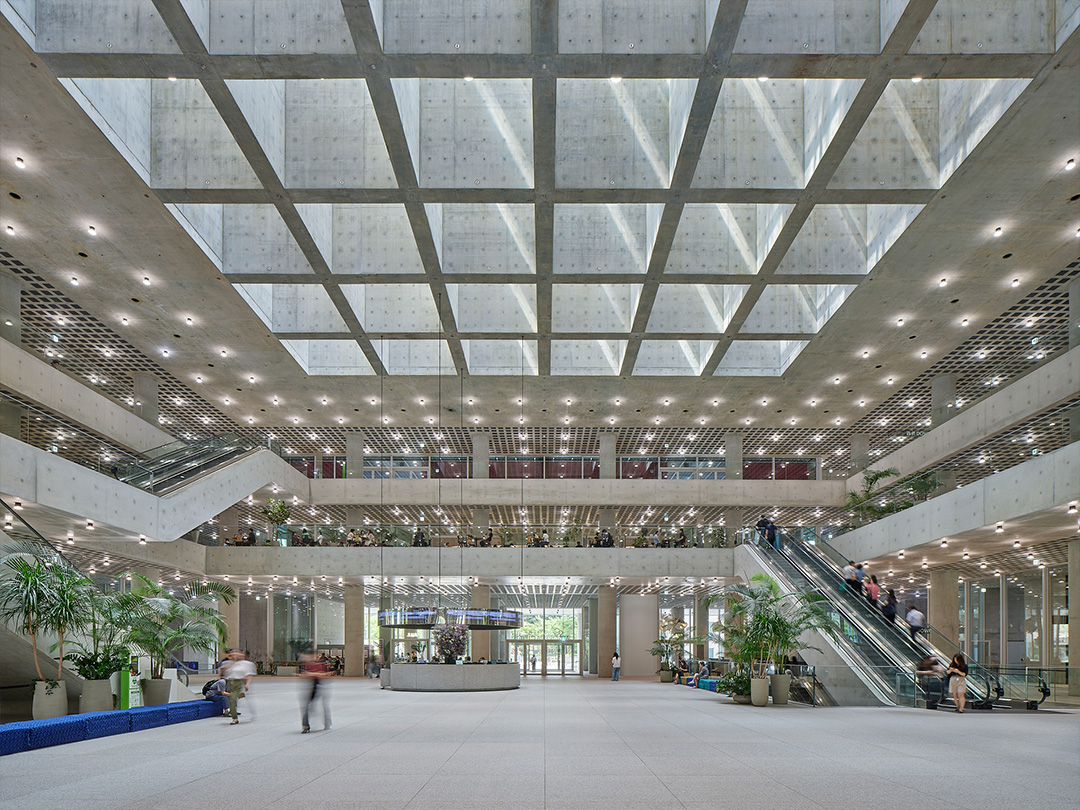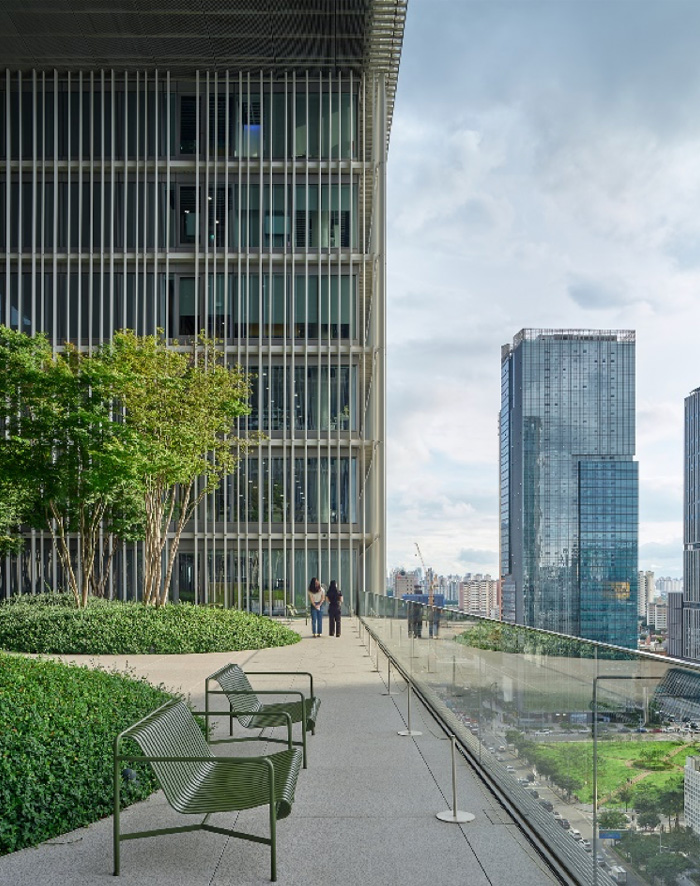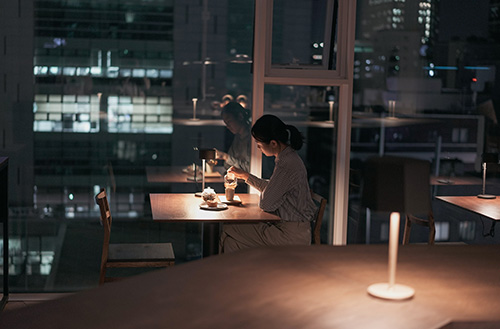

The World of Simple, Pale Ink

Amorepacific Headquarters
Written By
Park Sung-Jin CEO, Site & Page

One day in 2018, I decided to meet a friend residing in Huam-dong. While I seldom deliberately seek out trending neighborhoods, given the spontaneous opportunity, I had hoped to rendezvous in a hotspot of Huam-dong, Itaewon, or Gyeongridan-gil. Yet, the location he suggested was the Amorepacific Headquarters in Yongsan. Why meet at someone else's corporate building, bypassing all the delightful spots? It wasn't as if there was a distinctively branded mall beneath; no matter how aesthetically pleasing a lobby, its joy is merely visual. And with its corporate-building essence, wouldn't the discomfort be significant? My hesitance towards the Amorepacific Headquarters seemed justifiable given previous designs by renowned international architects. Particularly sensitive to space, I switched our meeting place, opting for a nondescript yet safe café near Yongsan Station. My first visit to the Amorepacific Headquarters came about a year later when I visited the “Seolhwa Cultural Exhibition.” I parked underground and ascended to the first-floor lobby. My precise initial reaction was, “What's this? This plaza is...”

A Building Embracing a Square, A Pond Reflecting the Sky
The first floor of Amorepacific Headquarters revisited for its 5th-anniversary special exhibition, “BUILDING. BEAUTY,” was still vibrant. Some leisurely sat on benches, letting moments dribble by; some awaited arrivals from above; others expressed surprise upon bumping into old acquaintances. Some stared blankly into space from the second-floor terrace, some waited in long queues outside the lecture hall, some swam between tall bookshelves, and others, kids in tow, sang a Pinkfong song. Even erasing from view the employees wearing their ID badges, this place was a melting pot of diverse individuals. Between purposeful strides were those of chance and leisurely strolls, with no palpable tension of entering an unfamiliar corporate lobby. The very function of a corporate headquarters lobby seemed an accessory to this unexpectedly delightful scenery.
Such a scene is certainly not typical for corporate buildings. What kind of place would have this ambiance? A square floor plan, an expansive indoor open space, terraces overlooking this vastness, the gentle hum filling the void in stark white, and even the circular information desk on the first floor. The feeling was akin to being in New York's Grand Central Terminal (minus BTS).
The square atrium is the genesis of this architecture and the epitome of its value. Typically, narrowing down from “outside to inside” or “whole to part” is preferable when discussing architecture. Still, with Amorepacific Headquarters, the journey from “inside to out” or “part to whole” is more intriguing. The will of the atrium, an intangible void, came first, with pillars, walls, and skylights mobilized as expressions of this existence. The layout and design of the low, comprehensive building, the vertical cores (elevators, stairs) tucked into corners, and the rooftop garden penetrating the building's upper echelons — all seem orchestrated to create this atrium. Most atriums are spatial mechanisms drawing in light from their depths, but this atrium directly responds to the city's and region's diversity. Thus, there's no real need to look outward and speak of the city. If Walter Benjamin of Paris and Kubo of Gyeongseong were to return to our times, they would likely spend their days wandering not in arcades or streets but here in this atrium.
Cafés, flower shops, wine bars, restaurants, stores, art galleries, libraries, and nurseries. Though seemingly disparate, these elements congregate, encircling a singular void, encapsulating the quintessential value of the company headquarters. At first glance, these functions may seem no different from the contemporary ground-level mixed-use complexes. However, ensuring these elements were not dismissed as mere commercialism is the architectural finesse of David Chipperfield, the underlying drive of Amorepacific towards connectivity and empathy, and the transcendent aura of the central mirror pond. Absent even one of these, the place might have devolved into an uproarious Panopticon.
Where Region and Culture Intermingle
In my experience, domestic corporate headquarters' ground levels and lobbies exude one of two atmospheres: solemnity or chaos. When tethered solely to their inherent functional role as workspaces, an exclusive boundary emerges, resembling airport checkpoints or subway turnstiles, with lobbies swathed in a surveillance-infused solemnity. Placing expensive art in the lobby to create a chic gallery ambiance is another manifestation of this gravity. Conversely, chaos is felt when the ground level is left untouched: the ambiance that arises when it operates as a separate shopping complex or food court. While convenience facilities are designated through distinct space branding and merchandise display, it does not signify the company building evolving into an inclusive space; rather, it delineates and separates the ground level. I find both unappealing, but the latter's disarray is even more off-putting.
In urban architecture, public spirit, locality, and commercialism walk a razor-thin boundary akin to two sides of a coin. While public spirit and commercialism may seem antithetical, the distinction is razor-thin. Public spirit and locality, though appearing similar, are fundamentally distinct. Architecture saturated in a singular value seldom fosters a favorable space. The Amorepacific headquarters pursues these universal architectural and urban values, blending culture with commerce, thereby sustaining dignity amidst vibrancy. The exterior exuberance the world should exhibit unfolds within.

To note that Amorepacific has maintained its position for six decades is not merely a matter of time. In human terms, it's akin to dwelling in one place from birth until one's sixtieth year. By this juncture, the affection for a location, or “topophilia,” transcends individuals and groups, naturally extending to regions and societies. The current openness of the Amorepacific headquarters, expanding beyond employees' workspace to embrace the surrounding area as a cultural hub, is rooted in its past, present, and potential future here. If they relocated and constructed new offices in places like Magok or Pangyo, such architectural presence would be nonexistent. From this perspective, this heritage edifice bridges Amorepacific's time, space, and culture.
The Moment Tradition Becomes Modern
Architect David Chipperfield presented the moon jar as a motif in his design for the Amorepacific headquarters. It's a relief that the direct visual connection between the moon jar's spherical shape and the headquarters' cubical design isn't immediately apparent. Instead, Chipperfield drew ‘inspiration’ from our unique aesthetic ‘sensation’ embedded within the moon jar, translating not its physical form or material but that exceptional ‘sensation’ into the abstract realm of architecture. The modest, rustic beauty of the moon jar, its low center of gravity, its sense of proportion, its restrained expression of presence; the moon jar represents a metaphor intrinsically linked with our architectural world. Thus, one hopes not to overexplain or overtly seek out this metaphor.
Photographer Koo Bon-chang, who has been instrumental in defining the moon jar in terms of Korean aesthetics today, produced works that might be more aesthetic and traditional than the moon jar itself. His photographs capture a world of emotionless, neutral, pale ink. It's the moment our tradition becomes modern. I wonder if I'm the only one sensing this realm of pale ink within the Amorepacific headquarters' atrium. Sitting on the second-floor terrace, I gazed vacantly for a long time. Then, it dawned upon me that this space had light but no shadows. While most atriums form a landscape reminiscent of Impressionist paintings with stark contrasts of light and shadow, here, every object and movement merges into the depths of pale ink. A deep moat surrounds the ground floor of the vast square space, and the light from the skylights scatters through the pond's water and a deep grid-like well structure. Consequently, the atrium basks in light without casting shadows. A typical corporate tower with tall, narrow curtain walls would not have achieved such a rustic, emotionless spatial expression and depth.

On September 25th, when I visited the headquarters, a guest lecture by architect David Chipperfield was held at Amore Hall. Five years after he designed the headquarters, he was again the center of global attention, winning the Pritzker Architecture Prize in 2023 — often dubbed the Nobel of Architecture. Leading figures in the domestic architectural community, the general public, and Amorepacific employees — over 400 attendees — graced the event. During the lecture, he shared his architectural philosophy and the background and intention behind the headquarters' design. One statement resonated in my ears: “This building isn't just a beautiful building or merely a beautiful design. It declares new values and principles for our society and city.”

Creating a building with a sleek and impressive design isn't as challenging as one might think. However, crafting a ‘place’ that transcends visual beauty and connects with the community and society requires immense effort and time. The Amorepacific headquarters isn't just a building; it has seamlessly integrated as a vibrant part of the city's daily richness.
‘Beauty Road’ encapsulates the stories of Amorepacific, which has created a beauty culture.
Every month, through the columns of experts on various topics, experience the values of Amorepacific from a unique perspective.
Written Park Sung-Jin
Photos photographer Roh Kyung / Mambo / Amorepacific
Video Mambo
Planning Amorepacific Communications Team
-
Like
0 -
Recommend
0 -
Thumbs up
1 -
Supporting
0 -
Want follow-up article
0





